
CSS Albemarle was a steam-powered casemate ironclad ram of the Confederate Navy, named for an estuary in North Carolina which was named for General George Monck, the first Duke of Albemarle and one of the original Carolina Lords Proprietor.

USS Galena was a wooden-hulled broadside ironclad built for the United States Navy during the American Civil War. The ship was initially assigned to the North Atlantic Blockading Squadron and supported Union forces during the Peninsula Campaign in 1862. She was damaged during the Battle of Drewry's Bluff because her armor was too thin to prevent Confederate shots from penetrating. Widely regarded as a failure, Galena was reconstructed without most of her armor in 1863 and transferred to the West Gulf Blockading Squadron in 1864. The ship participated in the Battle of Mobile Bay and the subsequent Siege of Fort Morgan in August. She was briefly transferred to the East Gulf Blockading Squadron in September before she was sent to Philadelphia, Pennsylvania for repairs in November.

USS Michigan was the United States Navy's first iron-hulled warship and served during the American Civil War. She was renamed USS Wolverine in 1905.

USS Onondaga was an ironclad river monitor built for the Union Navy during the American Civil War. Commissioned in 1864, the ship spent her entire active career with the James River Flotilla covering the water approaches to the Confederate States capital of Richmond, Virginia, although her only notable engagement was the Battle of Trent's Reach. After the war, she was purchased by France where she served as a coastal defense ship in the French Navy.
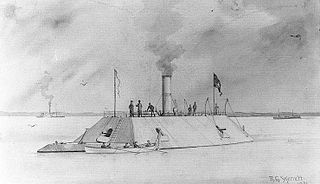
CSS Palmetto State was one of six Richmond class casemate ironclad rams built for the Confederate States Navy during the American Civil War. Completed in 1862, she defended Charleston, South Carolina and was burnt in 1865 to prevent her capture by advancing Union troops.

USS Canonicus was a single-turret monitor built for the United States Navy during the American Civil War, the lead ship of her class. The ship spent most of her first year in service stationed up the James River, where she could support operations against Richmond and defend against a sortie by the Confederate ironclads of the James River Squadron. She engaged Confederate artillery batteries during the year and later participated in both attacks on Fort Fisher, defending the approaches to Wilmington, North Carolina, from December 1864 to January 1865.
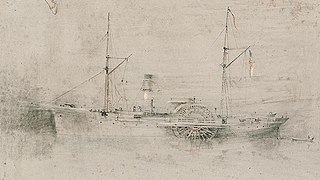
USSKeystone State was a wooden sidewheel steamer that served in the Union Navy during the American Civil War. She was a fast ship for her day and was used effectively to blockade Confederate ports on the Atlantic coast. She participated in the capture or destruction of 17 blockade runners. In addition to her military service, Keystone State had a lengthy commercial career before the war. Renamed San Francisco, she also sailed commercially after the war. The ship was built in 1853 and scrapped in 1874.

USS Fort Jackson was a wooden sidewheel steamer in the United States Navy during the American Civil War. She was successful in enforcing the Union blockade of Confederate ports, capturing five ships carrying contraband. She participated in the battles for Fort Fisher, which effectively closed the port of Wilmington, North Carolina to the Confederacy. Most notably, the surrender of Confederate forces in Texas was signed aboard the ship, formally ending the Civil War in that portion of the country.

USS Santiago de Cuba was a side-wheel steamship acquired by the Union Navy during the first year of the American Civil War. She was outfitted as a gunboat with powerful 20-pounder rifled guns and 32-pounder cannon and was assigned to the Union blockade of the Confederate States of America. She was notably successful in this role, capturing several blockade runners. Her last major action of the war was the assault on Fort Fisher, during which seven of her crew won the Medal of Honor.
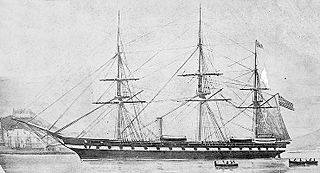
USS Roanoke was a wooden-hulled Merrimack-class screw frigate built for the United States Navy in the mid-1850s. She served as flagship of the Home Squadron in the late 1850s and captured several Confederate ships after the start of the American Civil War in 1861. The ship was converted into an ironclad monitor during 1862–63; the first ship with more than two gun turrets in history. Her conversion was not very successful as she rolled excessively and the weight of her armor and turrets strained her hull. Her deep draft meant that she could not operate off shallow Confederate ports and she was relegated to harbor defense at Hampton Roads, Virginia for the duration of the war. Roanoke was placed reserve after the war and sold for scrap in 1883.

USS Neosho, the lead ship of her class, was an ironclad river monitor laid down for the Union Navy in the summer of 1862 during the American Civil War. After completion in mid-1863, the ship spent time patrolling the Mississippi River against Confederate raids and ambushes as part of Rear Admiral David Porter's Mississippi Squadron. She participated in the Red River Campaign in March–May 1864. Neosho resumed her patrols on the Mississippi after the end of the campaign. She supported the Union Army's operations on the Cumberland River and provided fire support during the Battle of Nashville in December 1864. Neosho was decommissioned after the war and remained in reserve until sold in 1873.

USS Winona was a Unadilla-class gunboat built for service with the Union Navy during the American Civil War. Winona was heavily armed, with large guns for duels at sea, and 24-pounder howitzers for shore bombardment. Winona saw significant action in the Gulf of Mexico and in the waterways of the Mississippi River and was fortunate to return home safely after the war for decommissioning.
USS Dai Ching was a steam gunboat in commissioned into service in the United States Navy in 1863. She served in the Union Navy during the American Civil War until her loss in 1865.
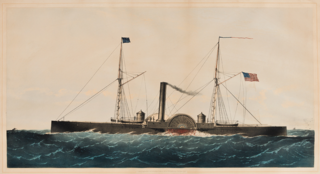
USS Osceola was a wooden, sidewheel Sassacus-class gunboat which saw combat with the Union Navy in the American Civil War. She was designed with shallow draft and double-ends specifically to allow her to operate in the narrow rivers and inlets along the Confederate coast. She was well suited to this role and took part in major battles on the James and Cape Fear Rivers.

USS Grand Gulf was a wooden-hulled, propeller-driven steamer acquired by the Union Navy during the American Civil War. She was effective in performing blockade duty, and captured a number of Confederate blockade runners.
USS Zouave was a steamer acquired by the Union Navy during the American Civil War. She was needed by the Navy to be part of the fleet of ships to prevent blockade runners from entering ports in the Confederacy.

USRC Naugatuck was a twin-screw ironclad experimental steamer operated by the U.S. Revenue Cutter Service during the American Civil War. She served the U.S. Treasury Department as the USRC E.A. Stevens, a name she retained until sold in 1890. She was loaned to the Navy by the Treasury Department and thus mistakenly referred to in U.S. Navy dispatches during early 1862 as "USS Naugatuck".
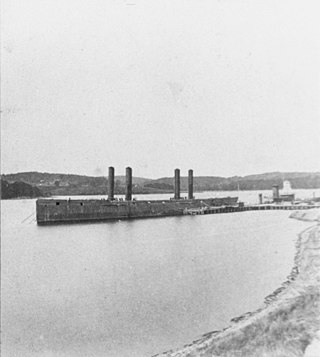
USS Neshaminy was a large and powerful 3,850-ton screw frigate with a length of 335 feet that was under construction at the Philadelphia Navy Yard when she was surveyed by Navy officials who found her construction work to be poor. Construction was halted by the Navy, which eventually sold her for scrap.

USS Peterhoff was a British ship captured by the Union Navy during the American Civil War. Condemned as a blockade runner, she served the Union Navy's struggle against the Confederate States of America as a gunboat.

CSS Ivy was a sidewheel steamer and privateer purchased by Commodore Lawrence Rousseau for service with the Confederate States Navy, and chosen by Commodore George Hollins for his Mosquito Fleet. The Mosquito Fleet was a group of riverboats converted to gunboats, and used to defend the Mississippi River in the area of New Orleans during the American Civil War.

















